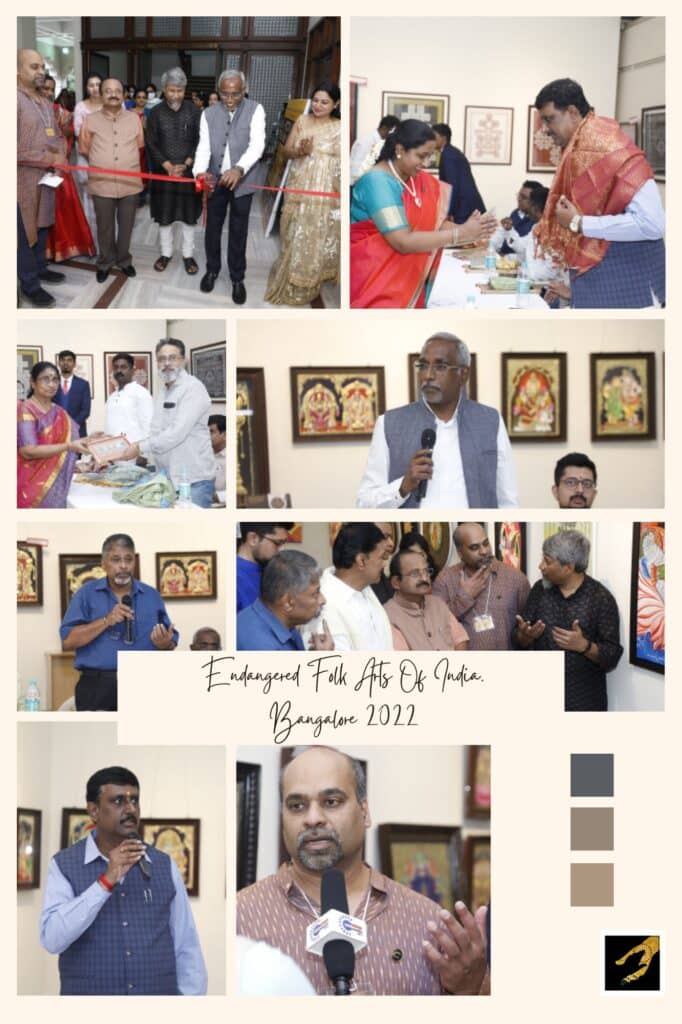
Endangered Folk Arts of India:
Bangalore Exhibition & Workshop 2022
My Experiences as a Volunteer – Dixit Soni
Endangered Folk Arts Of India
India is an amalgamation of ancient cultures and heritages. With more than 50 traditional folk arts indigenous and unique to India, Indian folk-art forms are full of cultural importance. But unfortunately, some of these art forms are now under the threat of extinction.
The folk arts that had been passed down from generation to generation for over 3000 years, now see the artists abandoning the craft. This is often due to factors like limited funding for the artists, diminishing public awareness of their art style, and pressure to move onto different careers to sustain themselves.
In order to pass on the Indian Folk arts to the next generation, International Indian Folk-Art Gallery (IIFAG), an Australian art organization has decided to aid this process by organizing Bangalore Exhibition & Workshop 2022.
Its mission is to conduct a knowledge transfer to the next generation, provide a dignified living to the artists and identify new talent through competitions and the like.
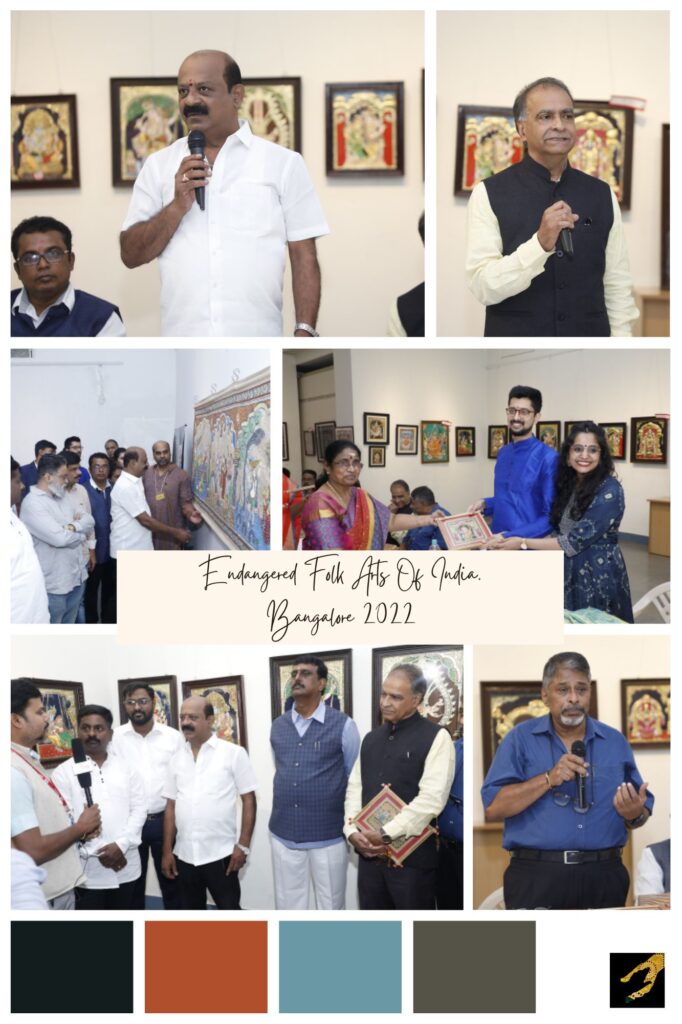
To popularize these Indian folk arts, IIFAG has started hosting art exhibitions exclusively featuring traditional Indian folk artists. The latest Exhibition & Workshop 2022 was hosted in Bangalore, India on the dates 16th-19th June 2022. I had the great honour of being present at this event as a volunteer and now, sharing my experience of the event.
My Experience at Bangalore Exhibition & Workshop 2022
Pre-Exhibition: Arriving in Bangalore
The event was held at the prestigious Karnataka Chitrakala Parishath. I arrived in Bangalore on the 14th of June. It was my first time in Bangalore so before going to the Kumara Krupa Guest house where I had been given lodgings, I decided to explore Bangalore a bit.
I discovered that Bangalore is a beautiful city and there was a place for art and culture among people. When I reached the lodgings, I prepared for the eventful day that was coming and eagerly awaited it.
The next day, I reached the venue of the exhibition and there I met up with all of the other volunteers that were there. We had a small icebreaker session and got to know each other and then we were assigned our duties.
There was a lot of work that we had to do in order to ensure a smooth experience on the actual day of the exhibition, so we immediately got to work. First, the volunteers went on to welcome all the artists that had come to get their art exhibited and we made a rapport with them, as we had to work closely for the next few days.
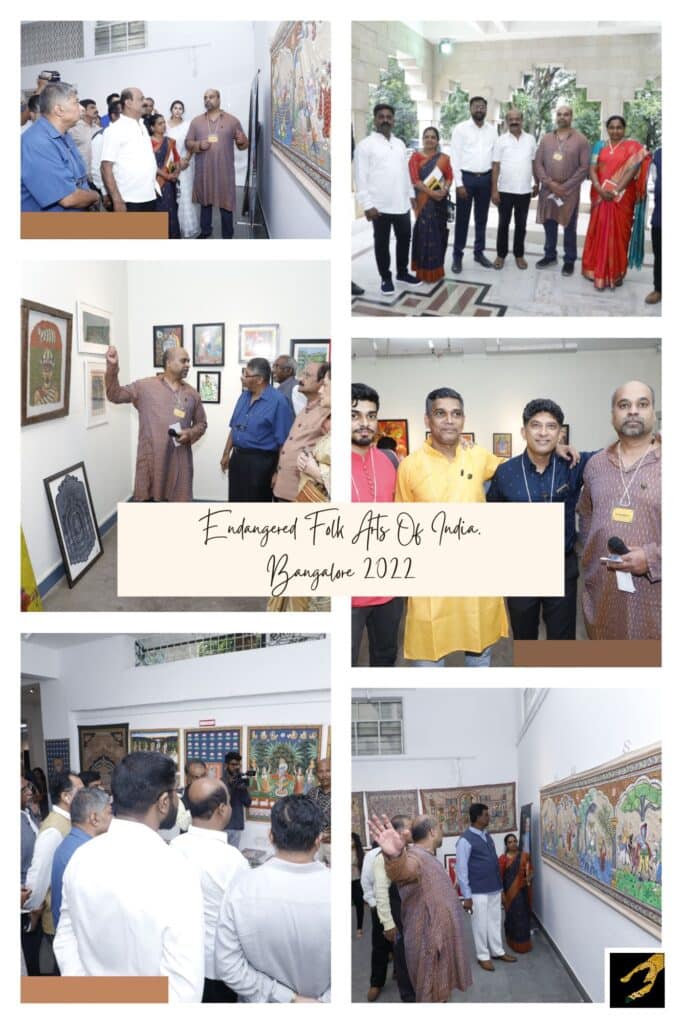
Next, at Bangalore Exhibition & Workshop 2022, the volunteers were given the task of unpacking the art and labelling the paintings with the artist ID and the artwork ID that had been provided to the artists beforehand.
Some artists had bought a lot of paintings, so it took time to tag each art piece properly.
It was crucial that we properly tag them as the artists had brought paintings that were for sale and some that were not. So, in order to ensure no problems during the Bangalore Exhibition & Workshop 2022, we meticulously worked with the artists to tag and label these artworks.
After the labelling was done, we kept the artworks in the galleries where they belonged in. There were 8 galleries and each gallery had its own theme.
Some galleries were segregated as geographical areas of India so that the artworks belonging to those areas would be kept there. There were also some galleries that had been segregated according to the culture or the style that the paintings in it belonged.
To inform the visitors about the contents of the galleries, we put up informative posters around the galleries. These posters informed about the history and the significance of the artworks within the galleries.
The Karnataka Chitra Kala Parishath also has a College of fine arts within its premises. The students from the various courses taught there were very enthusiastic about aiding with the preparations of the Bangalore Exhibition & Workshop 2022.
When asked about the reason for their enthusiasm, they replied that this was a precious learning experience for them.
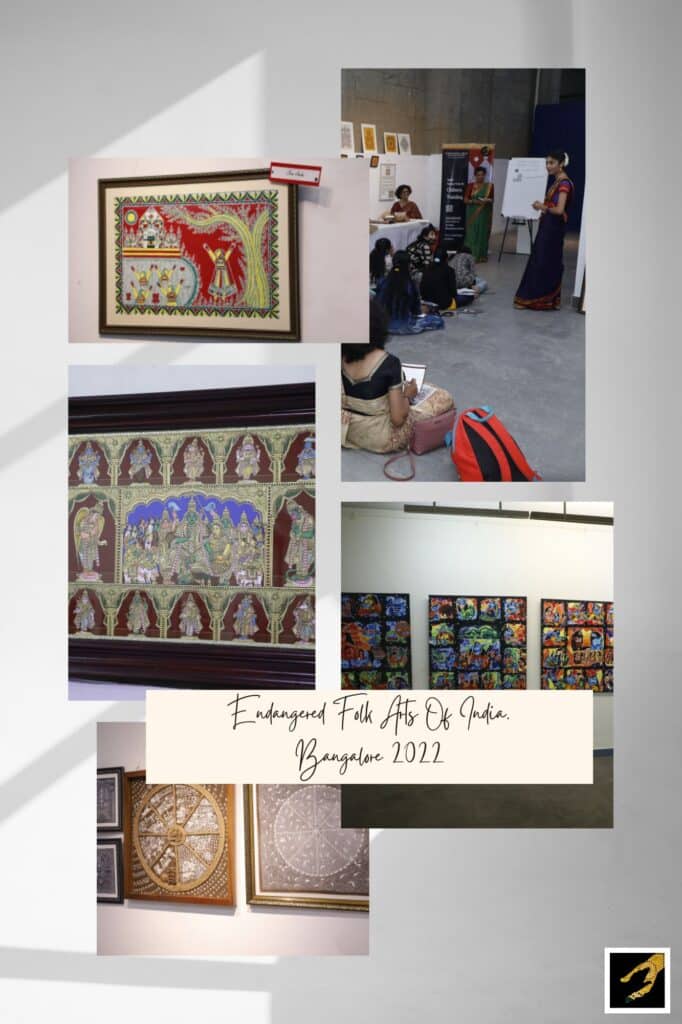
The help of the students was very helpful for the volunteers as they were able to communicate more effectively with the artists and they also were able to lead us around the campus.
The volunteers were provided meals at the south Indian canteen that was present on the college campus.
The students were also helpful while we tried to acquire supplies like gum, tape, labels, prints, or other stationery materials as they led us to the Art supplies store present on campus.
In the store, there was everything that an artist might need. From posters to canvases, from paints to pastels, everything was available there.
During the process of setting up everything, I got to talk to the artists, the volunteers, and the students and I even made some friends along the way.
Everyone had their own stories and everyone had come from different places but all of us were united by the fact that we were enthusiastic about IIFAG’s cause and decided to take part in the exhibition.
I was also working with a lot of people who were older than me and it was fascinating seeing them working with their own methods that had been tried and tested for a long time.
That day, we ran around the galleries from 9 A.M. to 10 P.M. It was a good experience, and afterward, I went back to my lodging and prepared myself for the day of the Bangalore Exhibition & Workshop 2022.
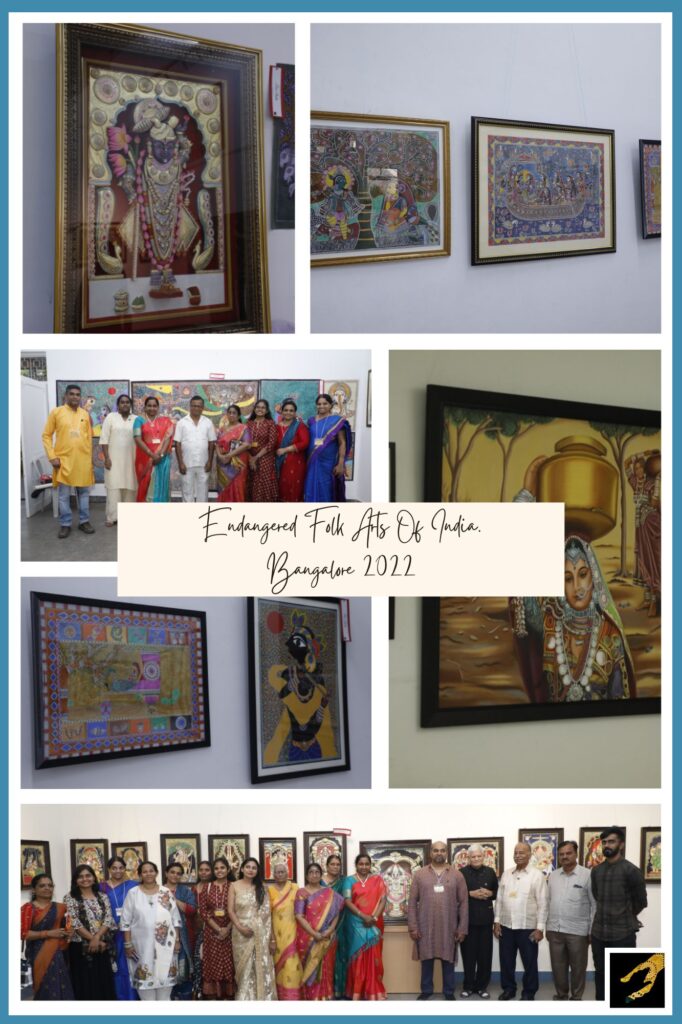
The Exhibition Day
On the day of the Bangalore Exhibition & Workshop 2022, I reached the venue a few hours earlier in order to look over any problems that had arisen and resolve them before the exhibition began.
I was running around for a while before everything felt perfect and then I ran to the registration desk to help with visitor registrations and guest arrivals.
Then, the inauguration began with the national anthem. Then the chief guest, Mr. V. Ramanathan, GM at TRIFED, Ministry of Tribal Affairs, led the inauguration with the cutting of the ribbon ceremony and lamp lighting. Then, the guests of honor were led to view the art in galleries 3,4 & 7. From then on, I had a very busy day.
The spotlight of this exhibition was the world’s Longest Pattachitra Painting, completed in a span of 35 days on Tussar silk by a group of highly skilled Pattachitra artists from Odisha.
The painting depicted the story of Sri Krishna painted in 14 segments along the length of the silk.
Each day was a great experience managing the crowd, resolving issues, and guiding the visitors around the exhibition. There were many art students from many different institutions.
Several students approached me throughout the course of the exhibition with inquiries about taking part in upcoming exhibitions and volunteering with IIFAG.
Their reasons for volunteering ranged from wanting to interact with the artists to actually joining IIFAG due to a shared love of folk arts.
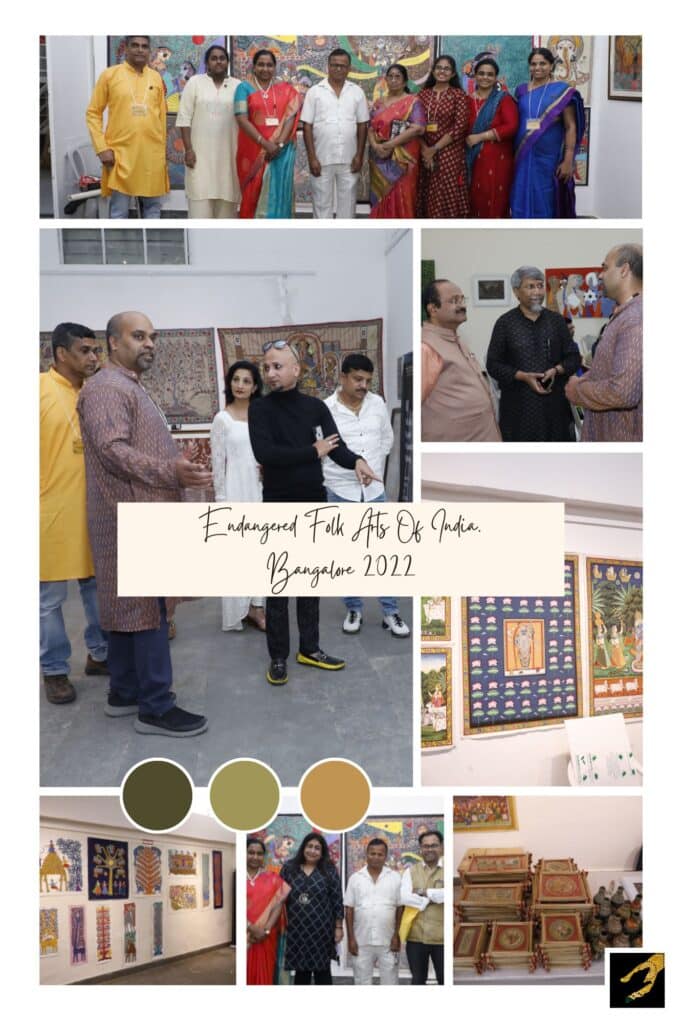
The spotlight exhibit had attracted a large crowd of viewers and thus there were many people going around, viewing the exhibits. As a volunteer, I was often asked about the paintings and the artist that had created them.
Some asked me to connect them to the artists and some asked me about the process of purchasing the art. I also witnessed the passion of the viewers when I saw a particular viewer getting lost in for more than half an hour in a particular painting.
There were several art collectors there who bought several pieces in different styles. They requested volunteers to lead them toward the different exhibits and galleries.
Apart from the viewers and collectors, there were also photographers, videographers, and local news crews. Everyone was very interested in the exhibits, especially the spotlight exhibit of the world’s longest Pattachitra painting, which attracted the largest crowds of viewers.
IIFAG had also set up an online gallery where people could purchase traditional clothes, accessories, and more that were either made from traditional methods or painted with the various styles of folk arts of India.
Another crowd attraction was the 9 workshops that were conducted by 10 artists on 9 different folk arts. There, people could learn the art style from the artists themselves.
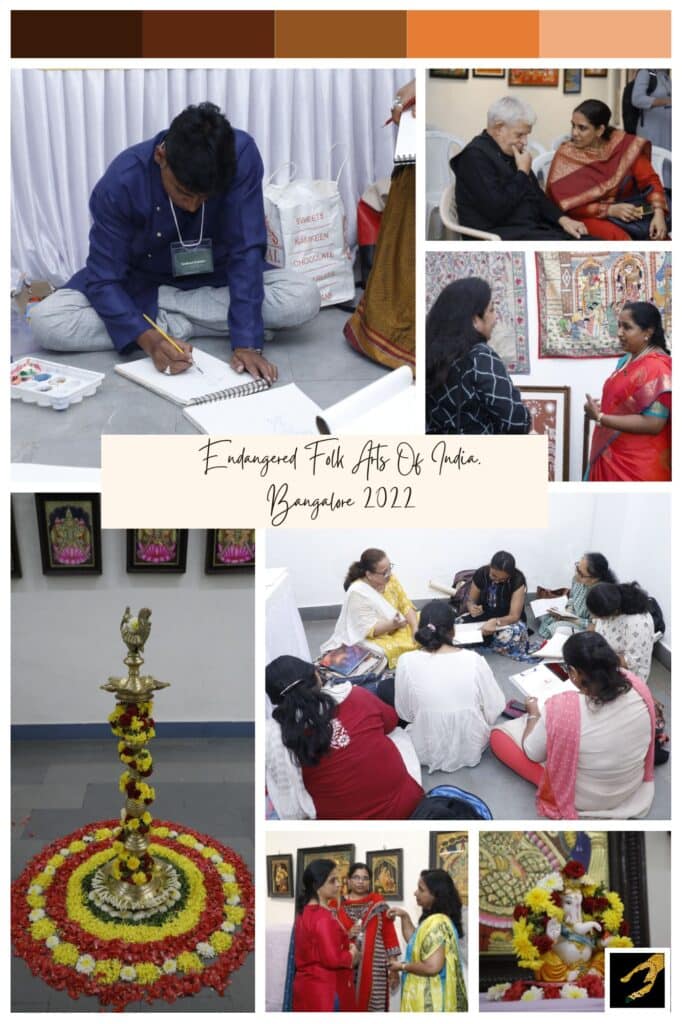
Indian Folk Art Workshops
The 9 workshops were based on-
Phad Painting
Phad style is a scroll painting and folk painting style practiced in Rajasthan. It was often made with a religious Intonation. Traditionally made on a long piece of cloth or canvas known as Phad.
The Phad painting style was taught by Artist Abhishek Joshi during the workshop.
Warli Painting
It is a tribal art style traditionally practiced by tribal people from the North Sahyadri range in Maharashtra. Warli style is majorly focused on the themes of mother nature and the wildlife surrounding them.
The Warli painting style was taught by Artist Anita Dalavi.
Pattachitra Painting
Pattachitra is a general term for traditional, cloth-based scroll painting, based in the eastern Indian states of Odisha and West Bengal.
The style is known for its intricate details as well as mythological narratives and folktales told through this medium. Pattachitra paintings are traditionally used to make narrative art.
The Pattachitra painting style was taught by Artist Sushant Maharana.

Kangra Painting
The Kangra style of painting was traditionally practiced in present-day Himachal Pradesh. The Kangra art style traditionally focuses on the Shringar Raas, or “The Flavor of Love” In the paintings done in this style.
Some old paintings depicted the love between Radha and Krishna or between Sita and Ram.
The Kangra style was taught by Artist Vandana Rajan.
Pichwai Painting
Pichwai paintings have a deep religious history, as originally, they were made only when commissioned by temples or priests for worship or ceremonies. Popular in present-day Gujarat and Mathura, it had a very deep relationship with Srinathji temples.
The Pichwai style was taught by Artist Daulat Ram.
Madhubani Painting
Madhubani style of painting originated in the Madhubani District of Bihar. The paintings are made with many tools, some conventional and some not.
Using natural dyes and pigments, they made paintings using eye-catching geometrical patterns. It traditionally focused on the lives of people and their association with nature and their deities.
The Madhubani art style was taught by Artist Avdhesh Kumar Karn.

Gond Painting
This style of art was practiced by one of the largest tribes in India, the Gond, predominantly belonging to Madhya Pradesh.
The main source of inspiration for Gond art was majorly nature but according to the Gond belief of everything possessing gods, even nature is depicted in a revering manner.
The workshop was taught by Artist Raman Sing Vyam.
Bhil Painting
The art style came from the homonymous tribe from where the style originated, Bhil. The tribe is very religious, with some bhils tracing their ancestry back to Eklavya and Valmiki.
Natural dyes are used to make paintings, traditionally on the clay walls of homes. They usually consist of large un-lifelike shapes filled with an overlay of uniformly placed dots.
The workshop was taught by Artist Shanta Bhuria.
Chittara Painting
Chittara paintings are intricate murals created by the tribal women of Malnad, Karnataka. The art style was considered almost extinct until recently when it was revived by Eshwar and Lakshmi Naik.
The class was conducted by Artists Amruthavarshini & Nandita Neige.
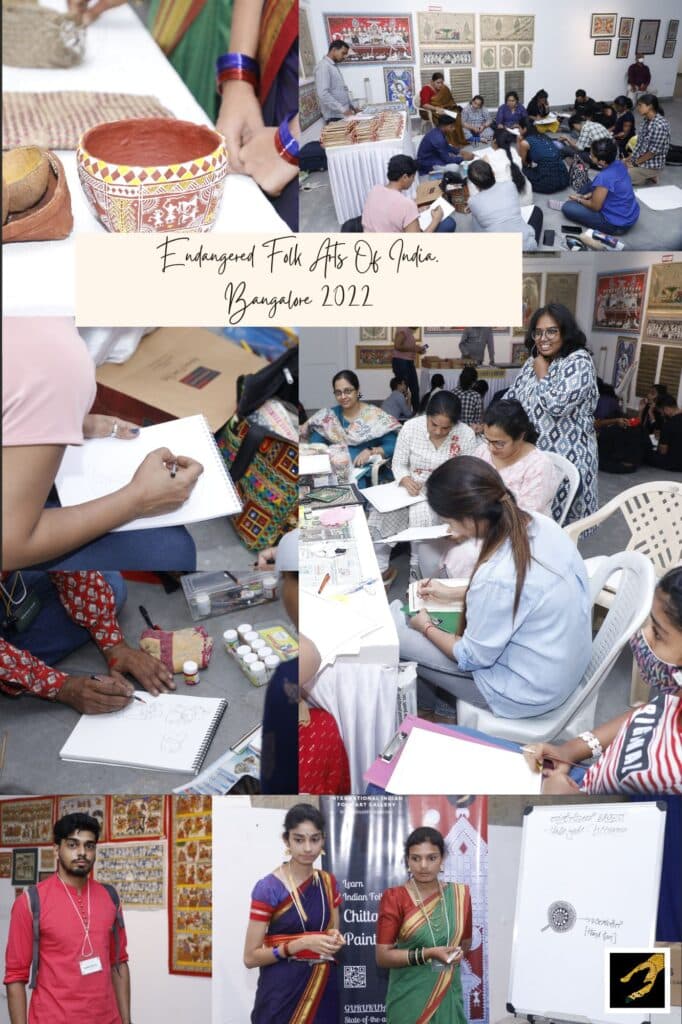
The Bangalore Exhibition & Workshop Ends Successfully
The Bangalore Exhibition & Workshop 2022 ended on the 19th and after the end of the exhibition, the volunteers were again mobbed with a huge amount of work. We tracked which pieces were sold and which were not.
After the tracking was done, we compensated the sales to the artists. Then we started to repackage the artwork for shipping.
The artwork had to be carefully packaged to not damage it and also, we had to keep each batch of artworks according to the artists.
This process took a long time and we came back to the lodgings quite late. I prepared to go back home feeling very content with the work I had done the past few days.
All in all, it was an opportunity of a lifetime to work with a beloved organization like IIFAG
It was also an honour to work closely with the Founder of the organization, Mr. Senthil Vel. In terms of learning, I got to learn tons from my experience of working with IIFAG, and from the experiences of Senthil Sir, when I approached them for help with any problems our team got stuck on.
I’m super excited to be a part of upcoming art Exhibition & Workshop.
If you want to be a part of the esteemed artist community of IIFAG, want to be a part of all the events and workshops, get your art showcased, and network with other artists, art collectors, and buyers, you should contact support@indianfolkart.org or WhatsApp +61414297179
Hello,
I’m Dixit Soni.
A business management student who’s learning about the kinds of businesses that have been made over the years.
But, as much as I’m intrigued by innovators creating solutions for the masses, I believe art and artists have a lot to learn from too .
The journey from an idea to your first draft sketch to the final piece is a marvelous process of self-discovery for the artist.
I admire the dedication and patience of artists towards their art, which makes me visit art exhibitions on weekends, the recent one being the IIFAG’s Endangered Folk Arts of India in Bangalore.
I have compiled my experiences from the event in the above blog.
Please give it a read. I hope you enjoy it. Please do leave your comments and feedback below.
Thank you!

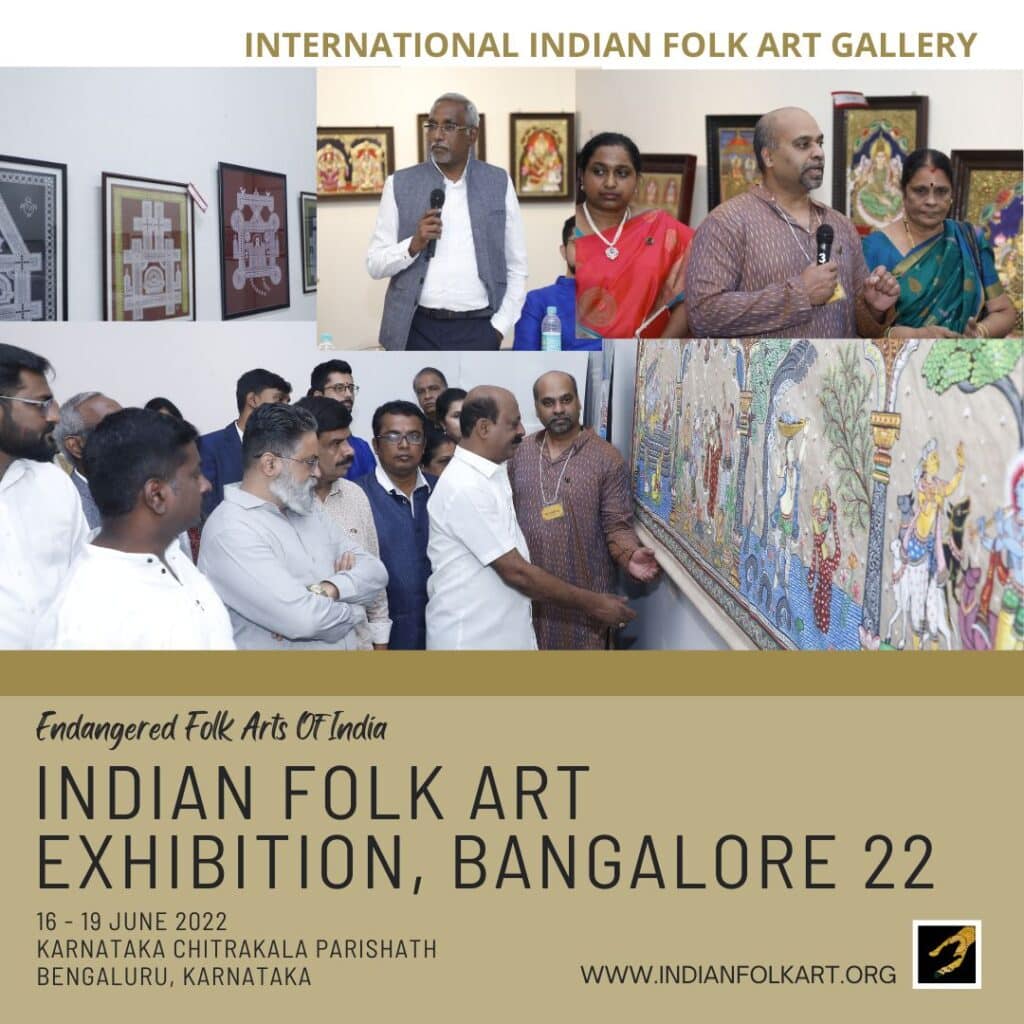
5 comments on “Bangalore Exhibition & Workshop 2022”
M SATHYAMOORTHY
Well portrait the details of the event 👌 and I am sure that there were lot many Dixit like you who gained first hand knowledge of not only our rich heritage , history etc but thr real status of art and their creator. Good thing that you shared your experience. Hope this helps you in your life.
Dixit Soni
It was definitely a learning experience that will help me going ahead. I, now, have experiences to extract learnings from, be it management, marketing, or problem-solving. Thank you for your kind words!
You can also read my LinkedIn post regarding the event here – https://www.linkedin.com/posts/dixitsoni_artgallery-artwork-folkart-activity-6960865128825171968-68qu?utm_source=linkedin_share&utm_medium=android_app
Dixit Soni
It was definitely a learning experience that will help me going ahead. I, now, have experiences to extract learnings from, be it management, marketing, or problem-solving. Thank you for the kind words!
You can also read my LinkedIn post regarding the event here – https://www.linkedin.com/posts/dixitsoni_artgallery-artwork-folkart-activity-6960865128825171968-68qu?utm_source=linkedin_share&utm_medium=android_app
Dixit Soni
It was definitely a learning experience that will help me going ahead. I, now, have experiences to extract learnings from, be it management, marketing, or problem-solving. Thank you for your kind words!
You can also read my LinkedIn post regarding the event here – https://www.linkedin.com/posts/dixitsoni_artgallery-artwork-folkart-activity-6960865128825171968-68qu?utm_source=linkedin_share&utm_medium=android_app
52 Incredible Indian Folk Art Forms That We Must Protect in Indian Art and Culture – International Indian Folk Art Gallery
[…] arts are artistic traditions that originated in a common context and were passed down through generations by being taught informally, this is so much the heart of our Indian Art and Culture. They include […]